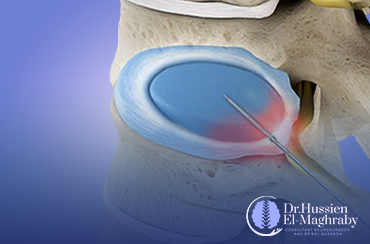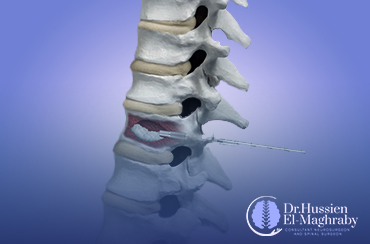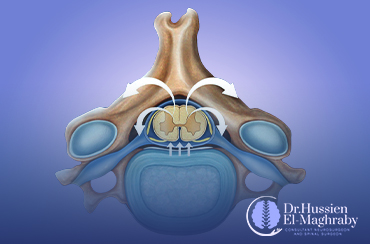
Percutaneous Laser Disc Decompression (PLDD)
Percutaneous Laser Disc Decompression (PLDD) is a painless procedure for treating back and neck pain that has become one of the most precise and effective techniques in spinal surgery. The laser device uses heat to vaporize soft tissue in the spine, relieving pressure from areas that cause pain. Dr. Hussien El-Maghraby; Consultant Neurosurgeon and Spinal Surgeon at University Hospitals Coventry and Warwickshire NHS Trust, England, United Kingdom performs laser disc vaporization to achieve optimal spinal health for his patients using the latest advanced techniques.
What is disc vaporization with laser?
Laser herniated disc vaporization is a minimally invasive procedure designed to correct herniated discs, involving the treatment of the herniated disc in the spinal cord by shrinking it with laser light delivered through a small incision made above the affected disc. Because the procedure is less invasive, it causes minimal pain, and patients recover quickly. The goal of laser disc vaporization is to vaporize a small portion of the inner nucleus, significantly reducing pressure inside the disc and thereby minimizing disc herniation.The spine consists of a series of small bones known as vertebrae, which form a hollow path or column that houses the spinal cord and protects it from injury and damage. The vertebrae stack over each other with discs in between to provide support. Most nerves exiting the spine pass through small openings in the vertebrae.
In some cases, such as injury, aging, or certain infections, the outer walls of any disc may leak, weakening the disc. This can lead to the bulging of the softer inner part, a condition known as disc bulge or herniation. A bulging disc can press on the spinal cord and nerves, causing symptoms such as tingling, weakness, or pain. In these cases, laser disc vaporization can remove the portion of the disc that is pressing on the nerves, providing relief.
Common symptoms that laser disc treatment can alleviate:
While the most common spine-related condition alleviated by laser disc vaporization is a bulging or herniated disc, there are also several other health conditions that this minimally invasive procedure can relieve, including sciatica, compressed nerves, and degenerative disc disease. Symptoms of these conditions affecting the spinal cord vary depending on the patient and the severity of the condition. Common symptoms experienced by patients include:• Leg or arm pain: In addition to localized pain in the area of the compressed nerve in the spine, patients may also experience sharp or radiating pain in the limbs. If the cervical spine is affected, they may feel pain in the shoulder and arm. If the compressed nerve is in the lumbar spine, they may feel pain radiating down the leg or buttocks. Pain may worsen with unexpected movements such as coughing or sneezing.
• Weakness: If the compressed nerve cannot send strong signals to the surrounding muscles, the patient may experience weakness in the foot and leg or hand and arm.
• Tingling or numbness: Patients may feel numbness or tingling spreading to the extremities, such as the foot or hand. This numbness or tingling is usually accompanied by pain in the leg or arm. Some patients may experience tingling or numbness without extended pain.
Suitable candidates for laser disc treatment:
• Laser disc vaporization may be recommended for individuals with herniated discs and associated symptoms, such as burning sensations, pain, weakness, or pain at the site of the compressed nerve.• Not everyone with a herniated or bulging disc requires laser disc vaporization. The procedure is performed on patients suffering from chronic pain that has not responded to conventional treatment options such as medications, physical therapy, weight management, pain relievers, and rest.
• Patients with a small, localized herniated disc causing severe pain are more suitable for this procedure.
• Individuals with a central, large, or protruding herniated disc are not suitable candidates for laser disc vaporization.
Steps of disc vaporization with laser:
Laser disc vaporization is a minimally invasive procedure, meaning you can return home on the same day of the procedure. You may need to stay in the hospital for a few hours. The procedure involves the following steps:• The anesthesiologist will apply local anesthesia along with mild sedation to prevent any discomfort or pain during the procedure.
• During the procedure, the surgeon will monitor your vital signs, such as heart rate and blood pressure.
• A nurse will clean and sanitize your skin with specific disinfectants.
• Under X-ray guidance to pinpoint the correct location, Dr. Hussien El-Maghraby will insert a thin surgical needle through the back to the target site.
• Then, Dr. Hussien El-Maghraby will insert specially designed optical fibers that emit laser energy to shrink the herniated disc by vaporizing the fluid inside the cartilage, which leads to relieving nerve and lower back pain.
• The surgeon will remove the surgical needle and place a small bandage over the incision to close it.
The success rate of laser disc vaporization:
Laser disc vaporization effectively relieves pain for most patients suffering from lumbar and cervical disc herniation. The success rate depends on several factors, including:• The degree of pressure on the spinal cord or nerve.
• The severity of the herniated disc.
• The duration the patient has experienced herniation.
• The presence of other medical conditions, such as obesity, diabetes, or hypertension.
On average, the success rate of laser disc vaporization is around 80%. The laser vaporizes the nucleus of the herniated disc, causing the bulging part to retract and relieve pressure on the nerves. This results in immediate pain relief. Also, the heat from the laser may help prevent pain from returning.
Recovery from laser disc vaporization:
Patients typically take one or two days off work after laser disc vaporization and can usually resume their normal activities. After the procedure, you may experience mild pain for a few days, which can be managed with anti-inflammatory medications and mild pain relievers. On average, patients undergoing laser disc vaporization begin to notice improvement in nerve or lower back pain within 10 to 14 days after the procedure.Risks and complications of laser disc vaporization:
• The risks of laser disc vaporization are less than those associated with open surgery, as complications are rare and the likelihood of infection is low. Dr. Hussien El-Maghraby uses sterilized equipment in the operating room and prescribes intravenous antibiotics before surgery.• The procedure is performed without muscle relaxants and under mild sedation. So if the needle accidentally contacts a nerve while being guided to the herniated disc site, the patient’s leg may move, alerting the doctor to adjust the needle before delivering laser energy. This ensures a safe procedure with minimal risk of nerve injury from the laser.
• Dr. Hussien El-Maghraby also monitors the leg for twitching or movement if irritation or heat reaches the nerve. If this occurs, the surgeon can immediately stop the laser to prevent nerve injury.
• Therefore, the procedure is not performed under general anesthesia, as the leg would not react similarly to any contact or irritation, meaning the surgeon would not detect nerve injury until after the patient awakens from surgery. Conducting the procedure under mild sedation helps the surgeon minimize the risk of nerve root injury.
Benefits of laser disc vaporization:
The laser disc vaporization procedure with Dr. Hussien El-Maghraby; Consultant Neurosurgeon and Spinal Surgeon at University Hospitals Coventry and Warwickshire NHS Trust, England, United Kingdom, offers numerous advantages compared to traditional spinal surgery. These benefits include:• This procedure is non-surgical and less invasive compared to conventional spinal surgery methods.
• Laser vaporization is a procedure that does not involve surgical opening and is painless.
• The procedure is performed in less than 20 minutes, eliminating the need for an overnight hospital stay.
• Laser disc vaporization can be performed under local anesthesia, making it suitable for all ages and individuals who may not be candidates for major surgical procedures.
• Local anesthesia helps prevent nerve injury and allows for patient monitoring during surgery to take necessary actions.
• The recovery period for this procedure is short, which minimizes lost work time.
• There is no damage to bones or soft tissues with this procedure.
• Patients do not require screws or rods, as the vaporization process does not pose a risk of spinal instability since tissue removal is minimal compared to traditional surgeries.
• It does not leave scars because it does not require incisions, unlike traditional surgeries.
We recommend addressing your herniated disc, whether cervical or lumbar, using the latest global techniques—laser vaporization—with the expertise of Dr. Hussien El-Maghraby; Consultant Neurosurgeon and Spinal Surgeon at University Hospitals Coventry and Warwickshire NHS Trust, England, United Kingdom to enjoy the benefits of minimally invasive interventions and rapid recovery.
شارك:
خدماتنا

الحقن الأسمنتي للفقرات
يتم علاج هشاشة العظام وكسور العمود الفقري بالتدخل الجراحي المحدود وحقن الأسمنت الطبي.

توسيع القناة العصبية بتقنية (3D Print) والذكاء الاصطناعي
يتم توسيع القناة العصبية القطنية والعنقية وتركيب المسامير والشرائح باستخدام الذكاء الاصطناعي AI والطبع بالبعد الثلاثي 3D Print.

تبخير الغضروف بالليزر بدون جراحة
علاج الانزلاق الغضروفي القطني والعنقي في دقائق، بالتدخل الجراحي المحدود بالليزر، لتبخير الغضروف الضاغط على العصب بدون ألم.

